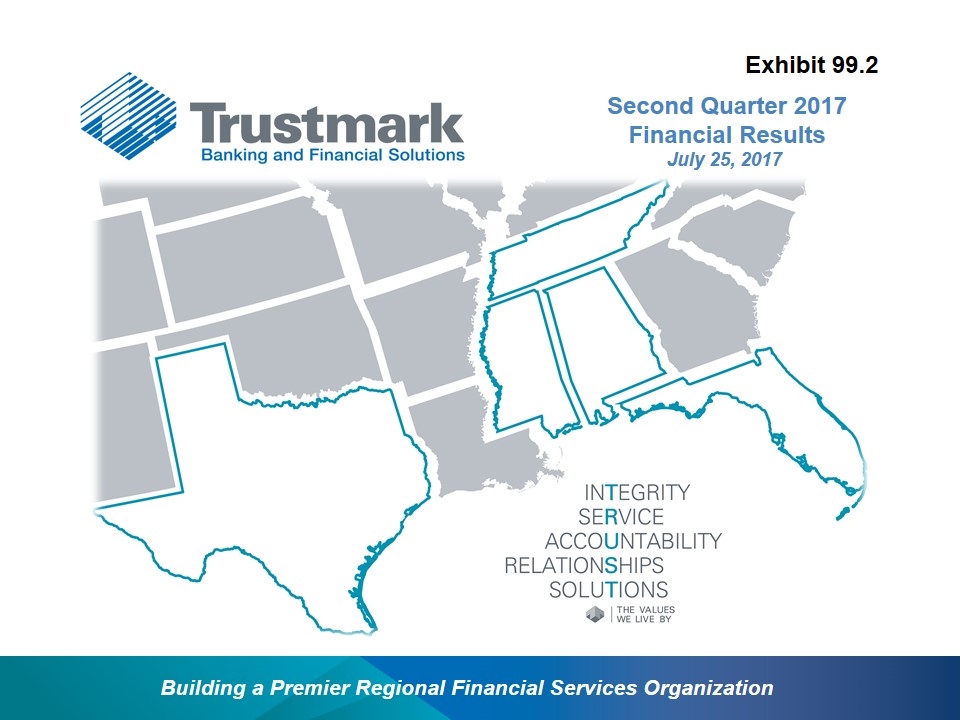
Second Quarter 2017 Financial Results July 25, 2017 Building a Premier Regional Financial Services Organization Exhibit 99.2
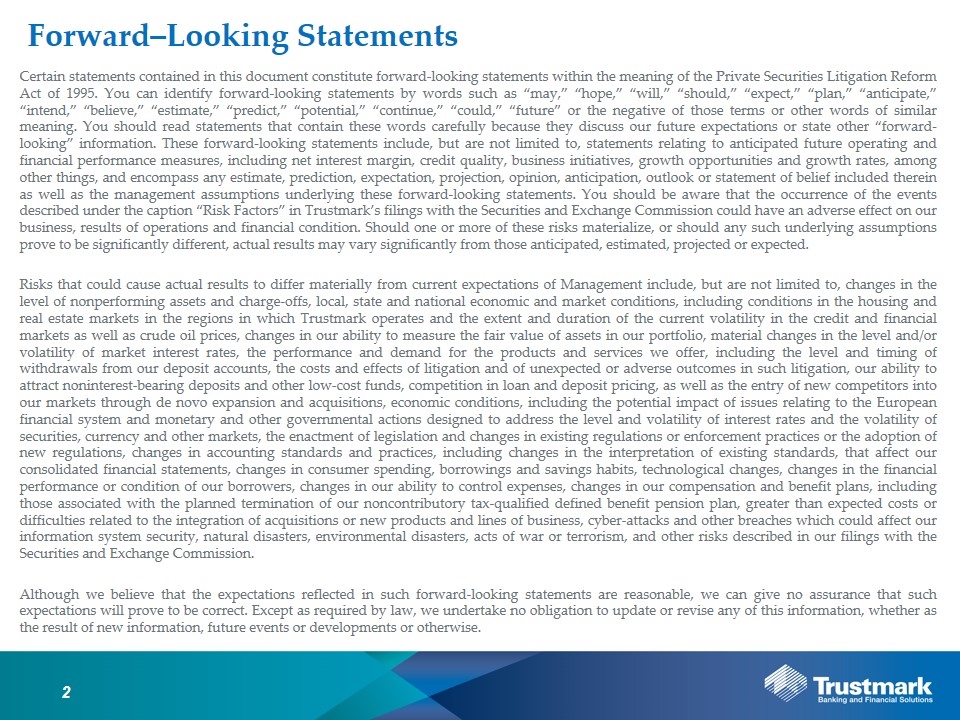
Forward–Looking Statements Certain statements contained in this document constitute forward-looking statements within the meaning of the Private Securities Litigation Reform Act of 1995. You can identify forward-looking statements by words such as “may,” “hope,” “will,” “should,” “expect,” “plan,” “anticipate,” “intend,” “believe,” “estimate,” “predict,” “potential,” “continue,” “could,” “future” or the negative of those terms or other words of similar meaning. You should read statements that contain these words carefully because they discuss our future expectations or state other “forward-looking” information. These forward-looking statements include, but are not limited to, statements relating to anticipated future operating and financial performance measures, including net interest margin, credit quality, business initiatives, growth opportunities and growth rates, among other things, and encompass any estimate, prediction, expectation, projection, opinion, anticipation, outlook or statement of belief included therein as well as the management assumptions underlying these forward-looking statements. You should be aware that the occurrence of the events described under the caption “Risk Factors” in Trustmark’s filings with the Securities and Exchange Commission could have an adverse effect on our business, results of operations and financial condition. Should one or more of these risks materialize, or should any such underlying assumptions prove to be significantly different, actual results may vary significantly from those anticipated, estimated, projected or expected. Risks that could cause actual results to differ materially from current expectations of Management include, but are not limited to, changes in the level of nonperforming assets and charge-offs, local, state and national economic and market conditions, including conditions in the housing and real estate markets in the regions in which Trustmark operates and the extent and duration of the current volatility in the credit and financial markets as well as crude oil prices, changes in our ability to measure the fair value of assets in our portfolio, material changes in the level and/or volatility of market interest rates, the performance and demand for the products and services we offer, including the level and timing of withdrawals from our deposit accounts, the costs and effects of litigation and of unexpected or adverse outcomes in such litigation, our ability to attract noninterest-bearing deposits and other low-cost funds, competition in loan and deposit pricing, as well as the entry of new competitors into our markets through de novo expansion and acquisitions, economic conditions, including the potential impact of issues relating to the European financial system and monetary and other governmental actions designed to address the level and volatility of interest rates and the volatility of securities, currency and other markets, the enactment of legislation and changes in existing regulations or enforcement practices or the adoption of new regulations, changes in accounting standards and practices, including changes in the interpretation of existing standards, that affect our consolidated financial statements, changes in consumer spending, borrowings and savings habits, technological changes, changes in the financial performance or condition of our borrowers, changes in our ability to control expenses, changes in our compensation and benefit plans, including those associated with the planned termination of our noncontributory tax-qualified defined benefit pension plan, greater than expected costs or difficulties related to the integration of acquisitions or new products and lines of business, cyber-attacks and other breaches which could affect our information system security, natural disasters, environmental disasters, acts of war or terrorism, and other risks described in our filings with the Securities and Exchange Commission. Although we believe that the expectations reflected in such forward-looking statements are reasonable, we can give no assurance that such expectations will prove to be correct. Except as required by law, we undertake no obligation to update or revise any of this information, whether as the result of new information, future events or developments or otherwise.
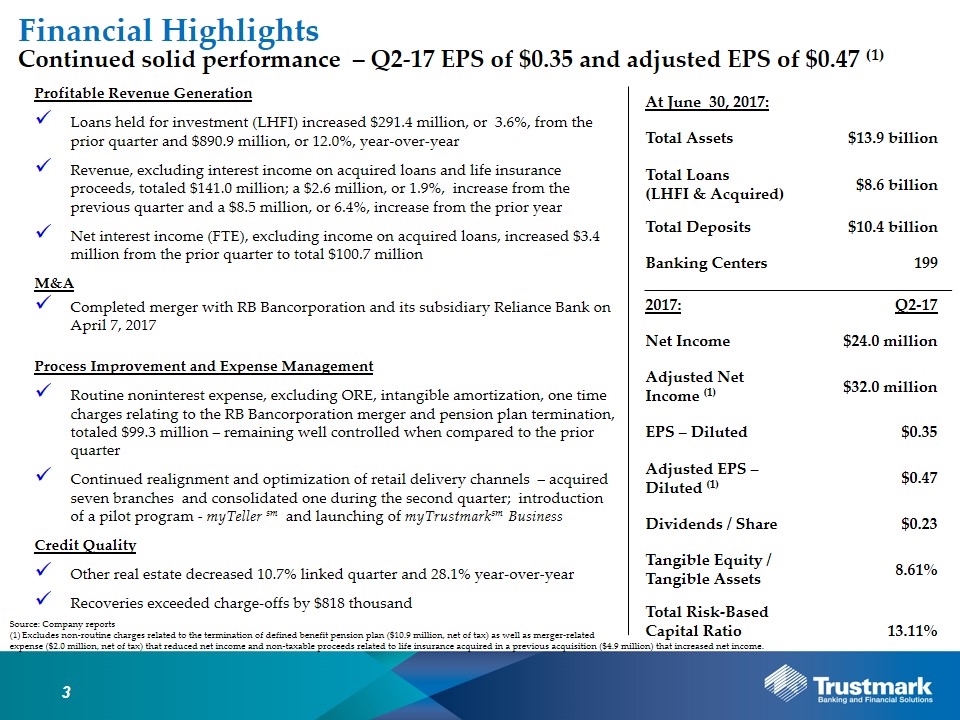
Financial Highlights Source: Company reports Excludes non-routine charges related to the termination of defined benefit pension plan ($10.9 million, net of tax) as well as merger-related expense ($2.0 million, net of tax) that reduced net income and non-taxable proceeds related to life insurance acquired in a previous acquisition ($4.9 million) that increased net income. Continued solid performance – Q2-17 EPS of $0.35 and adjusted EPS of $0.47 (1) At June 30, 2017: Total Assets $13.9 billion Total Loans (LHFI & Acquired) $8.6 billion Total Deposits $10.4 billion Banking Centers 199 2017: Q2-17 Net Income $24.0 million Adjusted Net Income (1) $32.0 million EPS – Diluted $0.35 Adjusted EPS – Diluted (1) $0.47 Dividends / Share $0.23 Tangible Equity / Tangible Assets 8.61% Total Risk-Based Capital Ratio 13.11% Profitable Revenue Generation Loans held for investment (LHFI) increased $291.4 million, or 3.6%, from the prior quarter and $890.9 million, or 12.0%, year-over-year Revenue, excluding interest income on acquired loans and life insurance proceeds, totaled $141.0 million; a $2.6 million, or 1.9%, increase from the previous quarter and a $8.5 million, or 6.4%, increase from the prior year Net interest income (FTE), excluding income on acquired loans, increased $3.4 million from the prior quarter to total $100.7 million M&A Completed merger with RB Bancorporation and its subsidiary Reliance Bank on April 7, 2017 Process Improvement and Expense Management Routine noninterest expense, excluding ORE, intangible amortization, one time charges relating to the RB Bancorporation merger and pension plan termination, totaled $99.3 million – remaining well controlled when compared to the prior quarter Continued realignment and optimization of retail delivery channels – acquired seven branches and consolidated one during the second quarter; introduction of a pilot program - myTeller sm and launching of myTrustmarksm Business Credit Quality Other real estate decreased 10.7% linked quarter and 28.1% year-over-year Recoveries exceeded charge-offs by $818 thousand
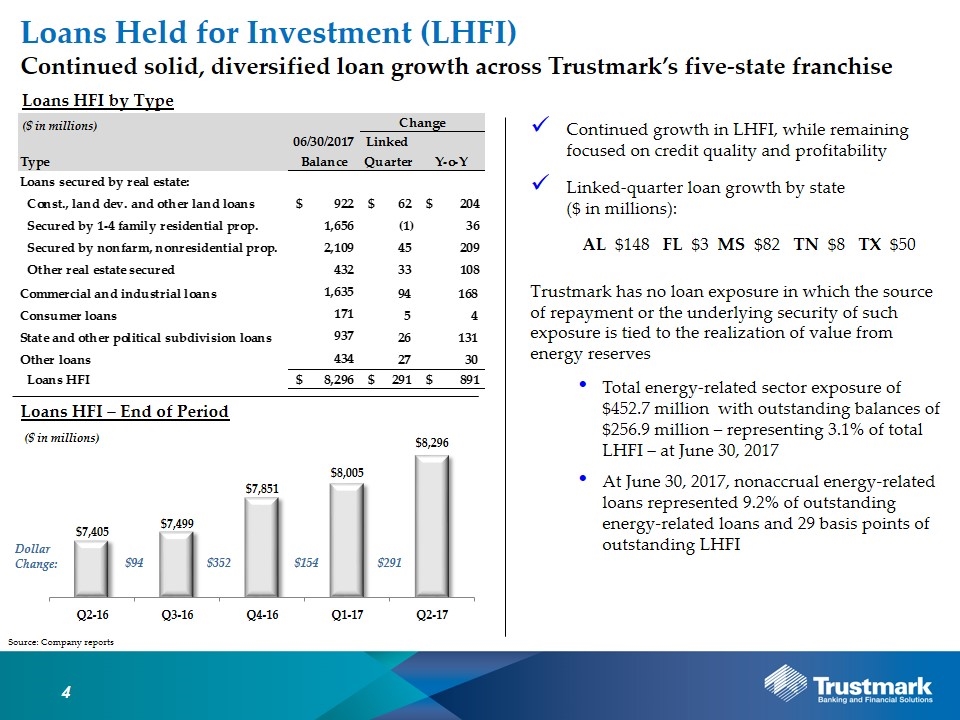
Source: Company reports Loans Held for Investment (LHFI) Continued growth in LHFI, while remaining focused on credit quality and profitability Linked-quarter loan growth by state ($ in millions): AL $148 FL $3 MS $82 TN $8 TX $50 Trustmark has no loan exposure in which the source of repayment or the underlying security of such exposure is tied to the realization of value from energy reserves Total energy-related sector exposure of $452.7 million with outstanding balances of $256.9 million – representing 3.1% of total LHFI – at June 30, 2017 At June 30, 2017, nonaccrual energy-related loans represented 9.2% of outstanding energy-related loans and 29 basis points of outstanding LHFI ($ in millions) Continued solid, diversified loan growth across Trustmark’s five-state franchise Loans HFI – End of Period ($ in millions) Loans HFI by Type Dollar Change: $352 $154 $291 $94
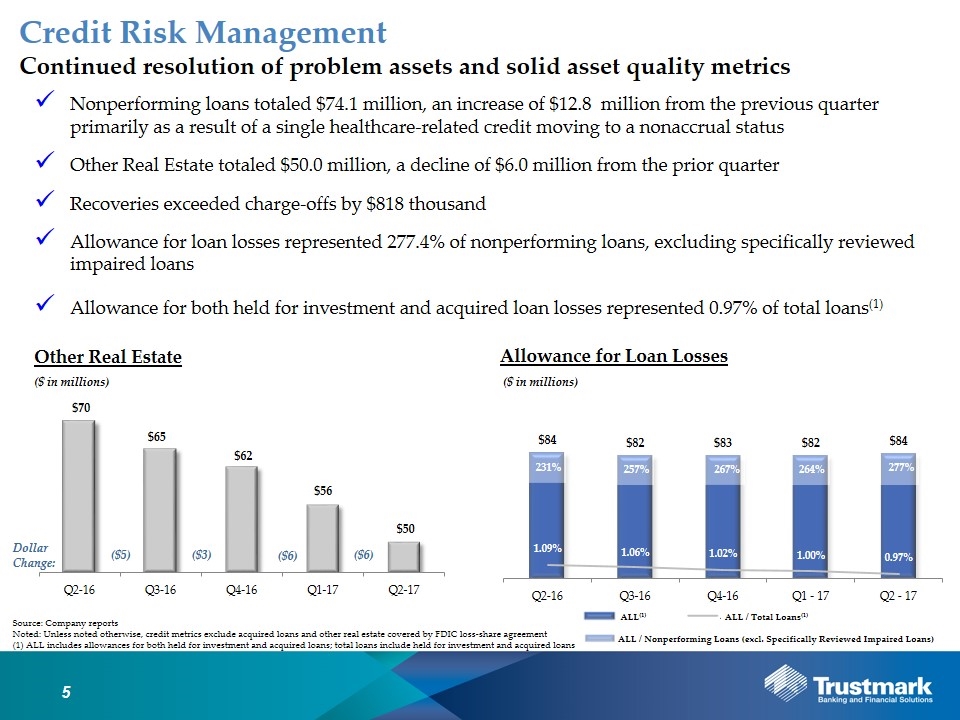
Nonperforming loans totaled $74.1 million, an increase of $12.8 million from the previous quarter primarily as a result of a single healthcare-related credit moving to a nonaccrual status Other Real Estate totaled $50.0 million, a decline of $6.0 million from the prior quarter Recoveries exceeded charge-offs by $818 thousand Allowance for loan losses represented 277.4% of nonperforming loans, excluding specifically reviewed impaired loans Allowance for both held for investment and acquired loan losses represented 0.97% of total loans(1) Credit Risk Management Source: Company reports Noted: Unless noted otherwise, credit metrics exclude acquired loans and other real estate covered by FDIC loss-share agreement (1) ALL includes allowances for both held for investment and acquired loans; total loans include held for investment and acquired loans Other Real Estate Allowance for Loan Losses Continued resolution of problem assets and solid asset quality metrics Dollar Change: ($6) ($3) ($6) ($5) 193% ($ in millions) ALL(1) ALL / Total Loans(1) ALL / Nonperforming Loans (excl. Specifically Reviewed Impaired Loans) 207% 210% 203% 231% ($ in millions) 264% 277% 231% 257%
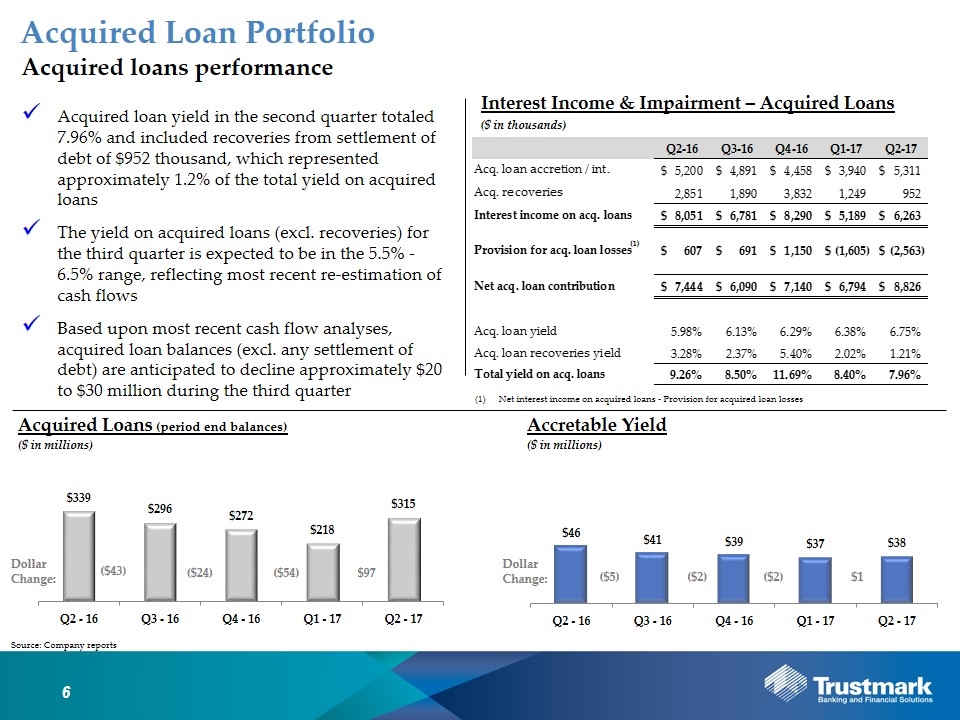
Acquired loans performance Source: Company reports ($ in millions) Acquired Loan Portfolio Acquired Loans (period end balances) Acquired loan yield in the second quarter totaled 7.96% and included recoveries from settlement of debt of $952 thousand, which represented approximately 1.2% of the total yield on acquired loans The yield on acquired loans (excl. recoveries) for the third quarter is expected to be in the 5.5% - 6.5% range, reflecting most recent re-estimation of cash flows Based upon most recent cash flow analyses, acquired loan balances (excl. any settlement of debt) are anticipated to decline approximately $20 to $30 million during the third quarter Accretable Yield ($ in millions) Dollar Change: ($54) Interest Income & Impairment – Acquired Loans (1) Net interest income on acquired loans - Provision for acquired loan losses $97 ($43) ($ in thousands) Dollar Change: ($2) $1 ($5) ($2) ($24)
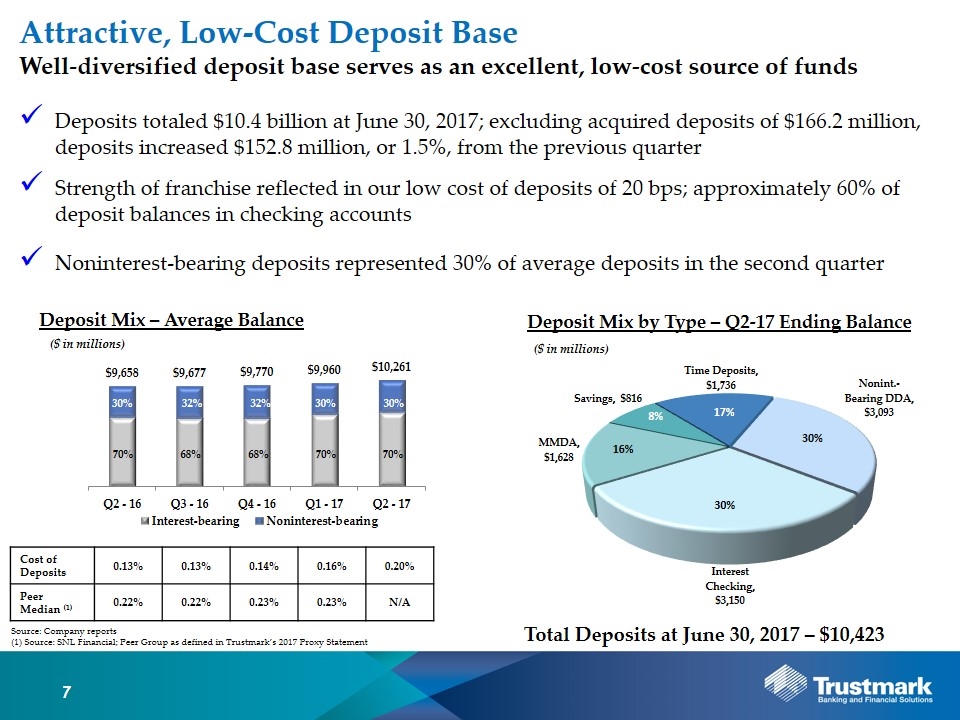
Deposits totaled $10.4 billion at June 30, 2017; excluding acquired deposits of $166.2 million, deposits increased $152.8 million, or 1.5%, from the previous quarter Strength of franchise reflected in our low cost of deposits of 20 bps; approximately 60% of deposit balances in checking accounts Noninterest-bearing deposits represented 30% of average deposits in the second quarter Source: Company reports (1) Source: SNL Financial; Peer Group as defined in Trustmark’s 2017 Proxy Statement Attractive, Low-Cost Deposit Base ($ in millions) Cost of Deposits 0.13% 0.13% 0.14% 0.16% 0.20% Peer Median (1) 0.22% 0.22% 0.23% 0.23% N/A Well-diversified deposit base serves as an excellent, low-cost source of funds Deposit Mix – Average Balance 30% 32% 32% 30% 30% 70% 68% 68% 70% 70% Total Deposits at June 30, 2017 – $10,423 ($ in millions) Deposit Mix by Type – Q2-17 Ending Balance 30% 30% 16% 17% 8%
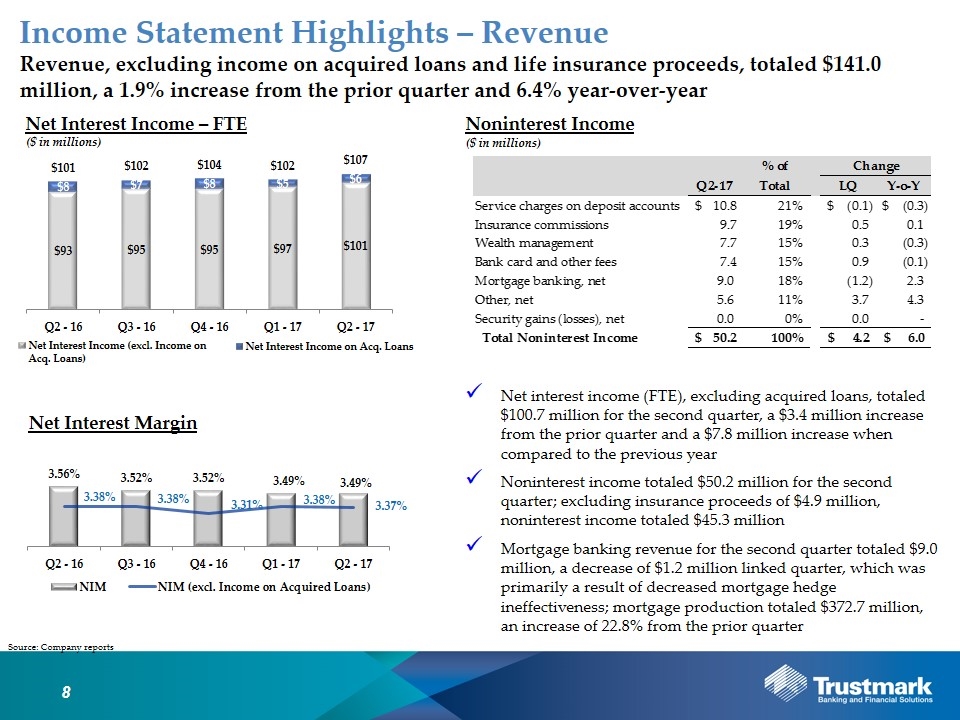
Income Statement Highlights – Revenue Revenue, excluding income on acquired loans and life insurance proceeds, totaled $141.0 million, a 1.9% increase from the prior quarter and 6.4% year-over-year Net Interest Income – FTE Net Interest Margin Noninterest Income ($ in millions) Net Interest Income on Acq. Loans Net Interest Income (excl. Income on Acq. Loans) Source: Company reports ($ in millions) Net interest income (FTE), excluding acquired loans, totaled $100.7 million for the second quarter, a $3.4 million increase from the prior quarter and a $7.8 million increase when compared to the previous year Noninterest income totaled $50.2 million for the second quarter; excluding insurance proceeds of $4.9 million, noninterest income totaled $45.3 million Mortgage banking revenue for the second quarter totaled $9.0 million, a decrease of $1.2 million linked quarter, which was primarily a result of decreased mortgage hedge ineffectiveness; mortgage production totaled $372.7 million, an increase of 22.8% from the prior quarter
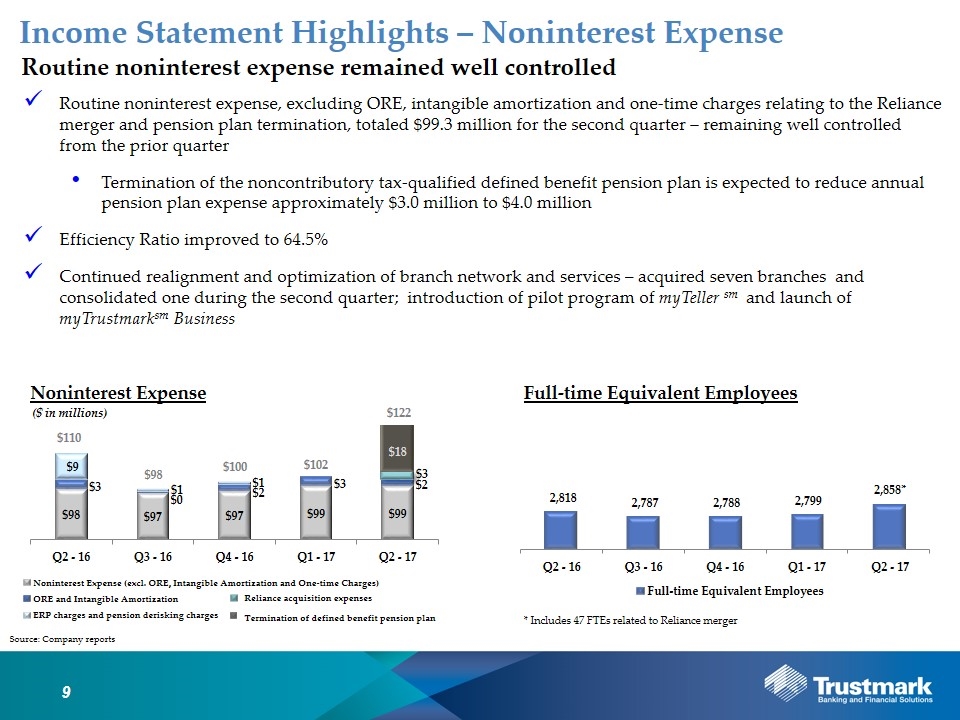
Income Statement Highlights – Noninterest Expense Source: Company reports Routine noninterest expense remained well controlled Routine noninterest expense, excluding ORE, intangible amortization and one-time charges relating to the Reliance merger and pension plan termination, totaled $99.3 million for the second quarter – remaining well controlled from the prior quarter Termination of the noncontributory tax-qualified defined benefit pension plan is expected to reduce annual pension plan expense approximately $3.0 million to $4.0 million Efficiency Ratio improved to 64.5% Continued realignment and optimization of branch network and services – acquired seven branches and consolidated one during the second quarter; introduction of pilot program of myTeller sm and launch of myTrustmarksm Business Noninterest Expense ($ in millions) Full-time Equivalent Employees Noninterest Expense (excl. ORE, Intangible Amortization and One-time Charges) ORE and Intangible Amortization ERP charges and pension derisking charges Reliance acquisition expenses Termination of defined benefit pension plan * Includes 47 FTEs related to Reliance merger
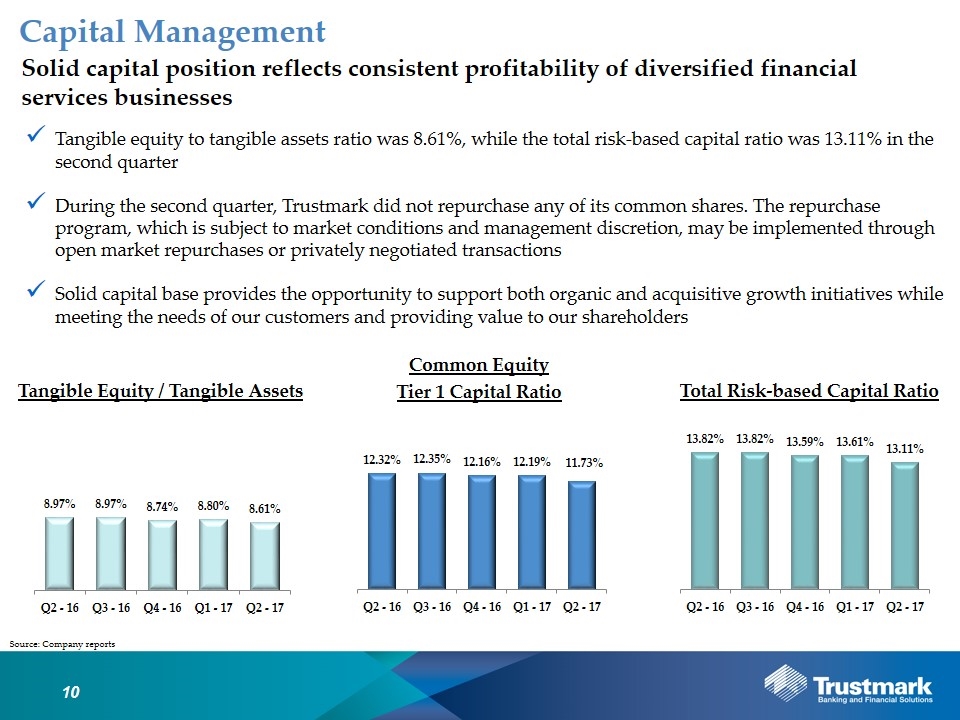
Capital Management Source: Company reports Tangible equity to tangible assets ratio was 8.61%, while the total risk-based capital ratio was 13.11% in the second quarter During the second quarter, Trustmark did not repurchase any of its common shares. The repurchase program, which is subject to market conditions and management discretion, may be implemented through open market repurchases or privately negotiated transactions Solid capital base provides the opportunity to support both organic and acquisitive growth initiatives while meeting the needs of our customers and providing value to our shareholders Solid capital position reflects consistent profitability of diversified financial services businesses Tangible Equity / Tangible Assets Common Equity Tier 1 Capital Ratio Total Risk-based Capital Ratio
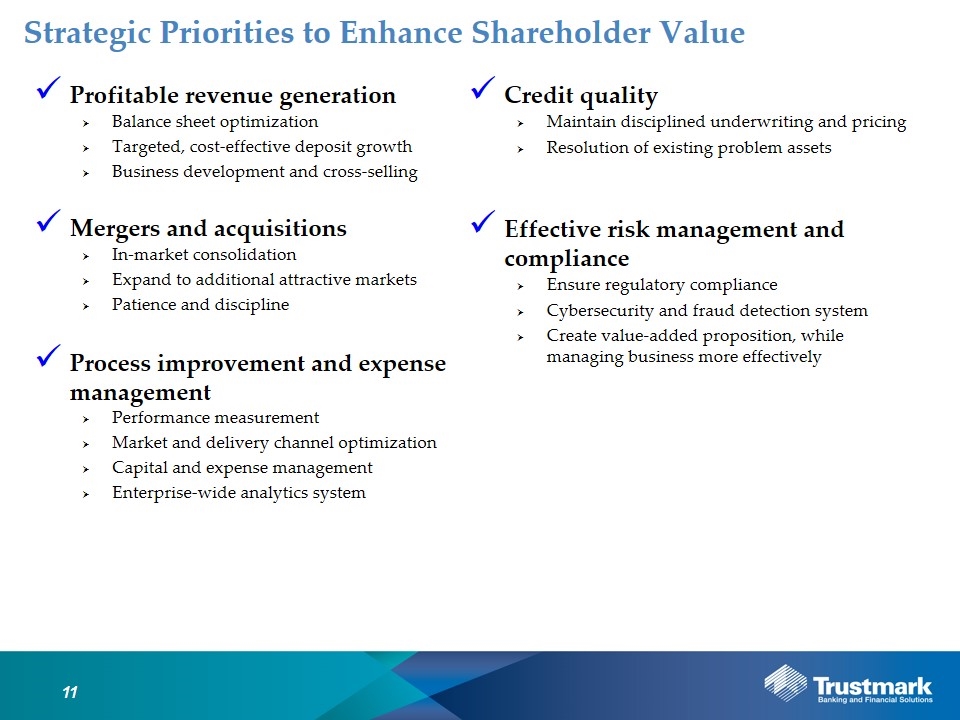
Profitable revenue generation Balance sheet optimization Targeted, cost-effective deposit growth Business development and cross-selling Mergers and acquisitions In-market consolidation Expand to additional attractive markets Patience and discipline Process improvement and expense management Performance measurement Market and delivery channel optimization Capital and expense management Enterprise-wide analytics system Strategic Priorities to Enhance Shareholder Value Credit quality Maintain disciplined underwriting and pricing Resolution of existing problem assets Effective risk management and compliance Ensure regulatory compliance Cybersecurity and fraud detection system Create value-added proposition, while managing business more effectively










